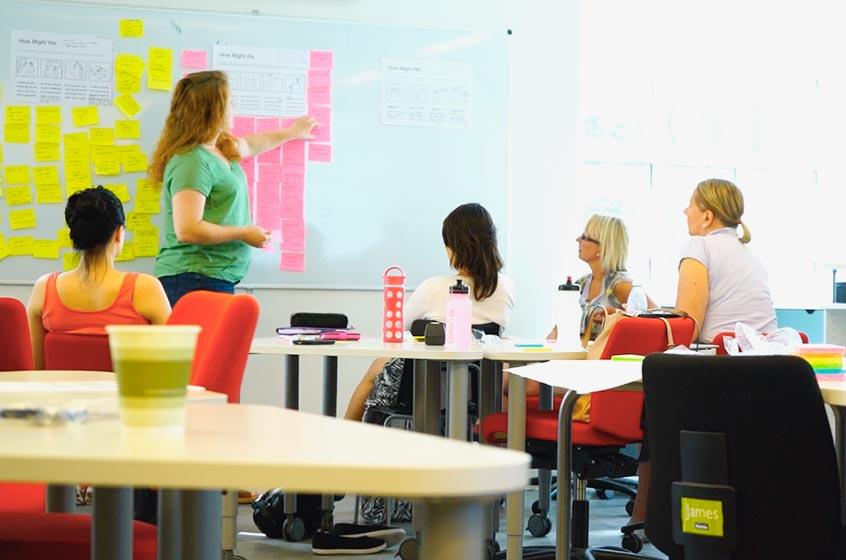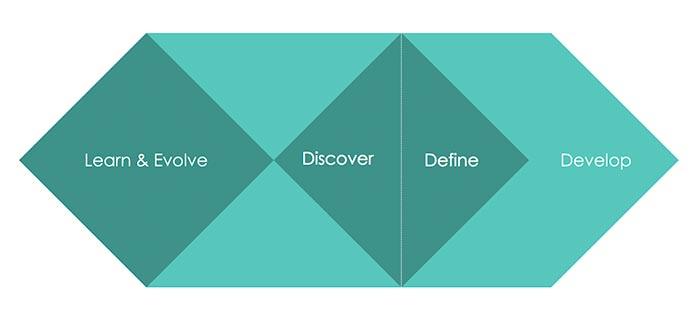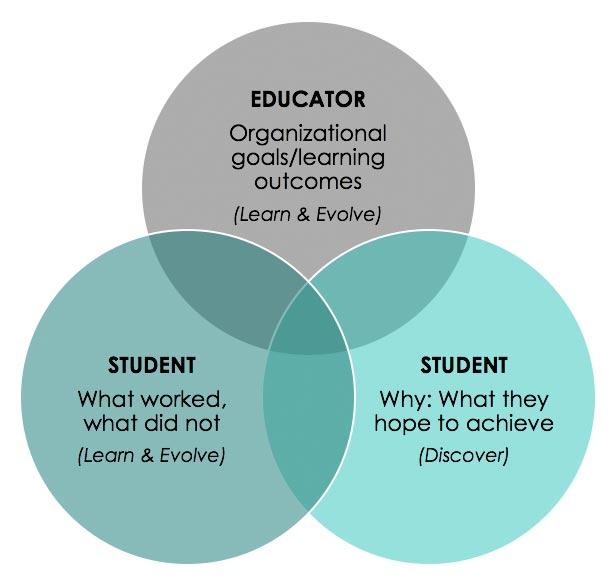
Authors: Ann Padley, Antti Piironen.
Introduction
The concepts of customer-centered and human-centered have grown in popularity in the business world to refocus on what really matters—the people an organization exists to serve. In the same way, the idea of student-centered learning is on the rise in higher education. This marks a paradigm shift from education as a vehicle for distributing knowledge to an avenue for facilitating learning and encouraging active student engagement (ESG 2015). It is a shift supported by a deeper understanding of the science of learning (Hinton, Fischer, Glennon 2012) and offers higher education an avenue for becoming more adaptable and responsive to the needs of students and those of our rapidly changing world (Ojasalo 2015).
The benefits for learners of a student-centered approach include increased motivation, sense of responsibility and engagement in learning (ESG 2015, 12; Bovill 2014, 21). The practical realization of such a paradigm shift requires new ways of thinking and working. This article presents a four-step process educators can use to rethink a learning experience using a collaborative, student-centered approach. The teacher becomes a designer partnering with students to understand their needs, interests and perspectives to inform the design of the learning experience.
First piloted to support Research, Development, and Innovation (RDI) for a professional summer school course called The Digital Wellbeing Sprint (The Sprint), the process helps educators work to understand what students hope to achieve from the learning experience. This understanding is integrated into the design along with the intended learning outcomes set by the educator or organization. This approach supports the alignment between student and teacher perceptions, thereby increasing the likelihood the experience will meet the expectations of both stakeholders (Könings et al. 2014).
Case: The Digital Wellbeing Sprint
Laurea, Haaga-Helia, and Metropolia Universities of Applied Sciences (UAS) organized the first joint Professional Summer School (PSS) in 2016 under the name Digital Wellbeing Co-creation and Start-up Summer School. Later renamed the Digital Wellbeing Sprint, the intensive two-week course brought together multidisciplinary teams of bachelor’s and master’s degree students to learn about service innovation using the ”Conceive Design Implement Operate” model (CDIO 2017).
Students solved real challenges from partnering organizations while learning tools and methods for co-creation and service design. In the first week, students explored their challenge by doing field and desktop research to learn about users, the service provider, the business environment, and relevant trends. Teams then generated ideas for a new service concept and spent the second week on prototyping, business model generation, and pitching their newly created concept to the clients (Piironen et al. 2017).
Armed with results and feedback from the first year, the newly formed UAS alliance wanted to apply the service innovation approach to develop The Sprint concept further, starting with gaining a better understanding of its own users: the students.
The process
The four-step process (Figure 1) used to pivot the design of The Sprint for 2017 combines the UK Design Council’s Double Diamond model (UK Design Council n.d.) with an education-based design process created by the American firm iDesign (Kilgore 2016). The integration of the two models frames the use of design methods within an educational context. Divergent thinking is used to explore multiple perspectives and convergent to make sense of what was learned and identify next steps. Each step in the process builds on the other, starting with Learn and Evolve, on to Discover, then Define, and finally Develop.

Step One: Learn & Evolve
In Learn and Evolve, one embraces past experiences by gathering the perspectives of the education delivery team and students. This feedback is used to Learn from the last implementation of the course then Evolve or iterate the learning experience. (Kilgore 2016).
Interviews and the analysis of existing data can both be useful in this phase. In the case project, six interviews 30-60 minutes long were conducted with planning and teaching staff. The goal was to hear varying perspectives on the course, understand the organizational goals, and begin to establish how the research would contribute to the further development of The Sprint. Existing sources of student feedback were also analysed including:
- open-ended questions from The Sprint application questionnaire
- responses to a survey distributed mid-way through The Sprint
- notes from interviews conducted during The Sprint by Piironen et al. (2017)
Student feedback was reviewed and categorized by development area, for example, communications, mentors, or curriculum. Comments related to each area were then further analyzed using an adapted Value Proposition Canvas (Osterwalder et al. 2014) to sort by pains (problems), gains (benefits or added value) and ideas for improvement. The goal of this step was to understand what elements contributed to the sense of value students experienced from The Sprint and which detracted from it.
In Learn and Evolve, insights from the staff interviews and student feedback offer immediate context and perspectives for the teacher-as-designer to consider in the ongoing development. This is where the analysis of feedback often stops, however, it is important to continue the process.
Step Two: Discover
Learn and Evolve offers insight into what perceptions students have of the experience—what worked and what did not. Discover offers the opportunity to dig deeper, to understand why. The focus of this step is to uncover what students hope to achieve through participation, or their Job to Be Done. This is a divergent step; the intention is to collect information and perspectives, making sense of them will happen in the next step, Define (UK Design Council 2007).
In Discover, interviews are used to gain insights from students. These interviews are not about asking students what they want; they are about understanding what the student is trying to accomplish (Bettencourt & Ulwick 2008). From this, one can form an understanding of the conditions for accomplishing their goal, the desired outcomes and the obstacles they face. In the case of The Sprint, six previous attendees were interviewed and the information collected was carried on to the Define stage.
Step 3: Define
In Define, a convergent step, one makes sense of the information collected thus far and defines, or redefines, the problems and opportunities. This step is about bringing actionable insights (Design Council 2007) and a deeper understanding of the learner into development. The process brings together the educators’ experience and the what and why of the student experience (Figure 2).

In the case of The Sprint, interviews with students were first analysed individually (see Patton 2001,41). The insights were then compared to identify patterns (see Christensen et al. 2016a, 59 or Kumar 2012, 141). The result was a set of statements summarizing what students hoped to achieve (see Silverstein, Samuel & DeCarlo 2012, 10). The statements fell into three main categories: the students wanted to learn from others, collect experiences, and take the next step. Within each category, core jobs and associated sub-jobs and outcomes were identified. For example, in learning from others, students hoped to a) learn from experienced professionals b) receive feedback to support their iterative learning process c) and learn from each other through peer-to-peer learning (see Padley 2017).
How might we questions were used to frame the findings as opportunities to feed into the development phase (IDEO 2012, 19; Berger 2012) and to bring together the student and educator perspectives. For example, by participating in The Sprint, students wanted to learn from experienced professionals and receive feedback to support their iterative learning process. A strategic goal of The Sprint is to support a smoother transition to working life. These perspectives were combined to ask, “How might we use mentorship and feedback to help students advance?” This question, in combination with the context from the research, could then be used by the development team to identify solutions that would meet the needs of both students and the organization.
Step Four: Develop
It is often not realistic to postpone development while focusing solely on research. In this model, Develop spans the length of the process representing development as an ongoing activity. This allows for an agile process and requires open communication and a willingness to adapt planning based on new insights. For example, early student and staff feedback about inconsistencies among the ten different projects in 2016 resulted in partnering with only one client during the 2017 Sprint. Student perceptions about the role of mentors and teachers inspired the addition of an afternoon training session for The Sprint support team. The training served to build shared best practices among the team and offer a deeper understanding of why students were attending The Sprint and what they hoped to gain. Finally, students’ desire for peer-to-peer learning further reinforced the multidisciplinary approach to learning.
Conclusions
The proposed four-step process offers one feasible way to move towards a more student-centered learning environment. It was developed during the Digital Wellbeing Sprint in 2016 and tested during the 2017 Sprint. It provides a framework which can be used to improve future implementations of the Digital Wellbeing Sprint or in developing similar learning events.
Taking a student-centred approach can drive innovation in education and improve learning outcomes and motivation of both the students and teachers.
Authors
Ann Padley, MBA in Service Innovation and Design, Teaching Fellow in Design Thinking, University of Bristol Centre for Innovation and Entrepreneurship, ann.padley(at)bristol.ac.uk
Antti Piironen, Ph.D. in Physics, Principal Lecturer in Smart Systems Engineering, Metropolia University of Applied Sciences, antti.piironen(at)metropolia.fi
[vc_tta_accordion active_section=”0″ no_fill=”true” el_class=”lahteet”][vc_tta_section title=”References” tab_id=”1458134585005-b3f22396-5506″]
Berger, W. 2012. The secret phrase top innovators use. Harvard business review. Accessed 22 February 2017. https://hbr.org/2012/09/the-secret-phrase-top-innovato
Bettencourt, L. & Ulwick, A.W. 2008. The Customer-Centered Innovation Map. Harvard Business Review. 86 (5) Accessed 3 January 2017. https://hbr.org/2008/05/the-customer-centered-innovation-map
Bovill, C. 2014. An investigation of co-created curricula within higher education in the UK, Ireland and the USA. Innovations in Education and Teaching International, 51(1), 15-25.
Christensen, C.M., Hall, T., Dillon, K., & Duncan, D.S. 2016. Know your customers’ ‘jobs to be done’. Harvard Business Review, 94 (9), 54-62.
ESG. 2015. Standards and guidelines for quality assurance in the European higher education area (ESG). Brussels, Belgium. Accessed 13 January 2017. http://www.eua.be/Libraries/quality-assurance/esg_2015.pdf?sfvrsn=0
Hinton, C., Fischer, K., & Glennon, C. 2012. Mind, brain, and education. Jobs for the Future. March 2012. Accessed 4 August 2017. https://studentsatthecenterhub.org/wp-content/uploads/2010/01/Mind-Brain-Education-Students-at-the-Center-1.pdf
IDEO. n.d. Design thinking for educators toolkit. IDEO LLC. Accessed 22 February 2017. https://designthinkingforeducators.com/
Kilgore, W. 2016. UX to LX: the rise of learner experience design. EdSurge, 20 June 2016. Accessed 20 December 2016. https://www.edsurge.com/news/2016-06-20-ux-to-lx-the-rise-of-learner-experience-design
Könings, K., Seidel, T., & Van Merrienboer, J. 2014. Participatory design of learning environments: integrating perspectives of students, teachers, and designers. Instructional Science 41(1). Article from Research Gate. Accessed 9 May 2017 https://www.researchgate.net/publication/259906316_Participatory_design_of_learning_environments_Integrating_perspectives_of_students_teachers_and_designers
Ojasalo, K. 2015. Using service design methods to improve student-centricity of higher education. In: International Business & Education Conference, New York City, August 2015.
Osterwalder, A., Pigneur, Y., Bernarda, G., Smith, A., & Papadakos, T. 2014. Value proposition design: how to create products and services customers want. 1st edition. Hoboken, New Jersey: Wiley.
Padley, A. 2017. Designing a student-centered learning experience: The Digital Wellbeing Sprint. MBA. Service Innovation and Design. Laurea University of Applied Sciences. http://www.theseus.fi/handle/10024/128728
Piironen, A.K., Haho, P., Porokuokka, J., Hirvikoski, T., Mäki, M. 2017. Experiences on a Multidisciplinary CDIO Project. The 13’th International CDIO Conference, Proceedings, 279-287. https://prism.ucalgary.ca/handle/1880/52101
UK Design Council. 2007. Eleven lessons: managing design in eleven global brands. Accessed 27 February 2017 http://www.designcouncil.org.uk/sites/default/files/asset/document/ElevenLessons_Design_Council%20(2).pdf
UK Design Council. n.d. The design process: What is the double diamond? Accessed 27 February 2017. http://www.designcouncil.org.uk/news-opinion/design-process-what-double-diamond
[/vc_tta_section][/vc_tta_accordion]



